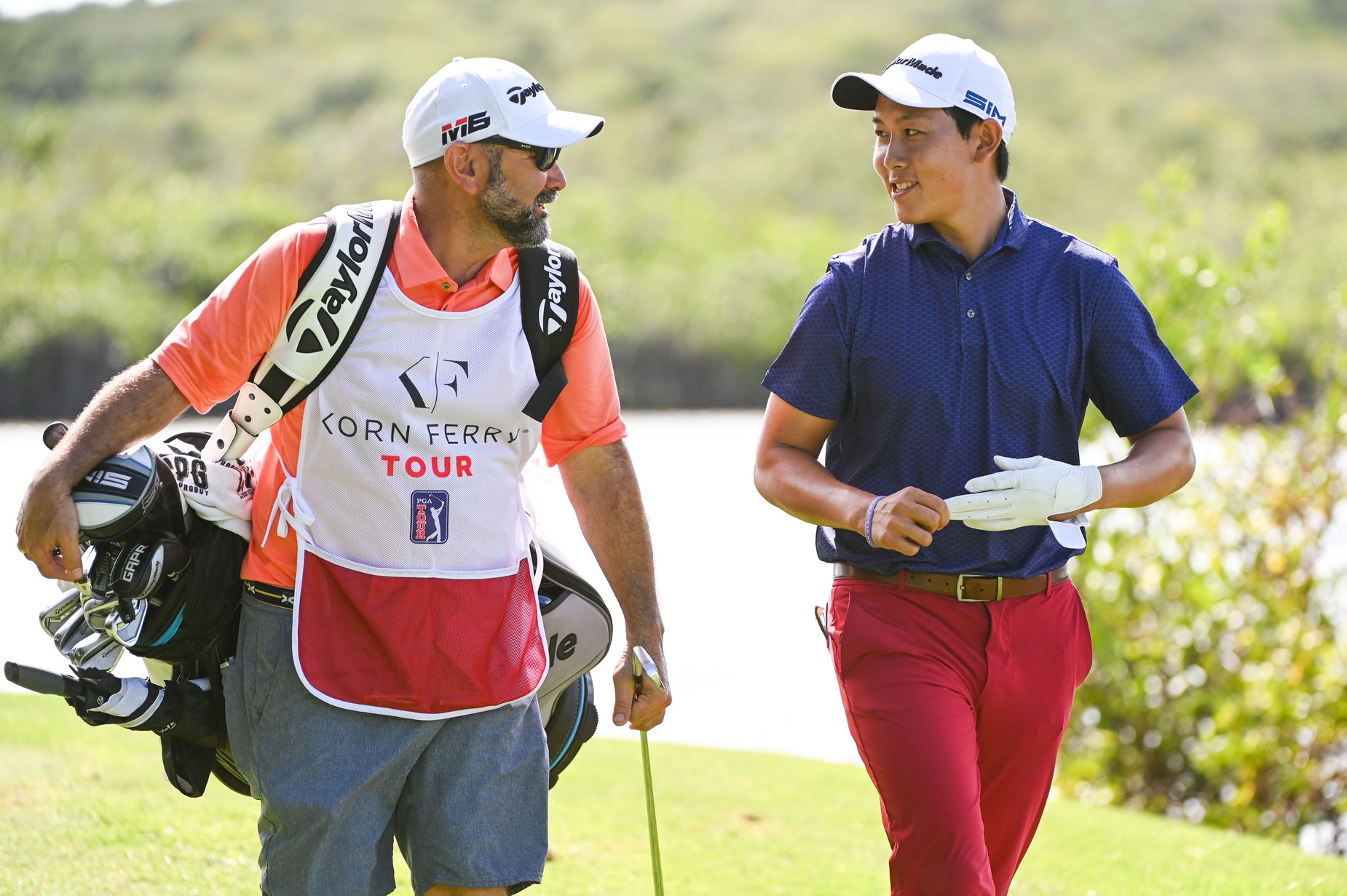By Daniel Rapaport
If you squint tight enough so you only see the lucrative tip of the professional golf iceberg, you’ll get the sense that the coronavirus hiatus has been … inconvenient. Boring, more than anything. PGA Tour pros are holed up in their mancaves—just as they should be—looking for something to occupy their time that would have been otherwise spent prepping for Augusta. Anything to stay busy. For some it means swinging lefty. For others, it’s hitting chip shots onto pool tables. Maybe it’s dancing. Or pelotoning.
Redirect your gaze beneath the surface, however, toward the gritty underbelly of life outside the PGA Tour, and you’ll see an entirely different reality. The stoppage has been totally and completely crippling.
The PGA Tour had completed 22 of its 49 scheduled events of the wraparound season and handed out more than $160 million in prize money when play halted. The Korn Ferry Tour, which does not have a wraparound season, has completed six events and handed out less than $4 million in prize money.
And in a cruel twist of fate, there are only five Korn Ferry events that take place outside the United States—the priciest events for players—and all five are front-loaded among the first six events of the year. They’ve already taken place.
“Right now, I think there are about 65 players have made more than $16,000 on the Korn Ferry Tour,” said Mark Baldwin, currently 58th in the Korn Ferry Tour’s season-long points race. The top 25 at the end of the regular season receive PGA Tour cards. Baldwin is almost spot on, by the way. Sixty-seven players have surpassed $16,000 in earnings. Safe to say he’s had time to take a look at the money list.
“Those first six events—especially that event in the Bahamas—are so expensive,” says Baldwin, a 36-year-old who is playing his second full year on the Korn Ferry Tour. “That can easily cost $3,000 to $5,000, and then you have your caddie expense. So by the time you’re done with those six events, you’re basically breaking even at $16,000.”

Ryan Young/PGA Tour
Baldwin played the more expensive early-season KFT events and thinks he earned just enough to break even.
Before the world turned upside down, the KFT was set to start its swing through the southern United States, allowing players to drive from tournament-to-tournament and greatly reduce expenses. After a two-week hiatus—the last Korn Ferry event finished on March 1—there were to back-to-back tournaments in Louisiana, one in Georgia, one in Texas, one in Alabama, one in Tennessee, one in Missouri, then back to Tennessee. Eight events in nine weeks. Prime earning season.
Instead, KFT members are stuck at home with, save for a few mini-tour events out west, no place to play and, more importantly for many, no income source in sight. Six of those eight events have been cancelled, the other two postponed. What becomes of the prize money in the cancelled events is unclear; Korn Ferry Tour officials declined comment for this story. The hiatus is likely to drag on even longer, too. When the season starts again is truly anyone’s guess.
It’s not just the on-course earnings that are drying up—the vast majority of endorsement deals for KFT players are contingent upon how many starts they make. Player X receives Y dollars from Company Z each time Player X plays in a tournament. No tournaments, no money.
Quite the time to have a kid, eh? Baldwin’s wife gave birth to the couple’s first child, Miles, on March 14.
“The baby and I have found comfort watching old Masters broadcasts on YouTube,” Baldwin said. “Fortunately, I earned a substantial paycheck in the final KFT event before the suspension, which will sustain us for a while.”
The check he’s talking about: $19,988 for finishing T-7 in the El Bosque Mexico Championship. For comparison, each of the 144 players who teed it up in the one round of the Players Championship, even the ones who shot 78 or 79, received a check for $52,083. Only 18 players on the Korn Ferry Tour have made that much for the entire season thus far.
“We’re just kind of left standing around,” said Conrad Shindler, 31, currently 73rd in the KFT points race. “This is our income. No one has a second job. No one has time for a second job. So to be stranded with no source of income, it’s tough.”
Now they have more time than they know what to do with. Shindler has gotten creative—he’s giving online lessons. Simply send him a video of your swing and Venmo him $20, and the former PGA Tour cardholder will send you back a detailed, five-ish minute video with analysis. He’s done 47 so far.
“It’s a little more time consuming than I thought, but I’m all for it,” Shindler said. “The hard part is, the files are too big to just email someone. So I have to load it into Dropbox and then send that. That’s the time-consuming part.
“A month ago, I never thought Dropbox would be a part of my daily life. But it is now.”
The stoppage has been difficult for every Korn Ferry player, albeit for different reasons. Consider the situation of Dylan Wu, whose career has been progressing steadily. A 2018 graduate of Northwestern, he played a season on the Mackenzie Tour before getting Korn Ferry status for this year. In his six starts this year, the 23-year-old has not finished worse than T-27 and has already had three top 10s, including a T-4 in the last event before the cancellations. He’s playing some of the best golf of his life, well on his way toward earning a PGA Tour card. And then this happened.

“There are positives and negatives,” Wu said. His efforts this year have netted $115,318. He’s financially secure right now. “On one hand, I’m playing well, so I feel like I want to play every week.”
That’s the negative. But there’s also a positive, albeit an awkward one: “The one good thing, there are eight events that we aren’t playing so far—even if they add a few more, technically it gets me closer to getting a PGA Tour card.”
On the other end of the run-out-the-clock-out spectrum is Jonathan Garrick, a UCLA graduate. Last year, in his fourth season on the Mackenzie Tour, he finally finished 10th on the order of merit—a significant number because the top 10 are guaranteed some level of status on the KFT. But he hasn’t gotten into one field yet this season, and the few Monday qualifiers he’s entered have yielded no luck. When he sat down at the beginning of the season, he figured he’d start to get some opportunities around May, when players being to voluntarily take time off to rest.
“I don’t have any guaranteed money coming in,” the 26-year-old said. “That’s really it. It sucks. I don’t know what’s going to happen with my status. You don’t know if they’re going to wipe the season, or if it’s going to be pro-rated.
“And now that the season is going to be shorter, I’m not going to get into any events because no one is going to skip anything. My chances of getting in off my status now are zero. I’m going to have to Monday qualify, which is so tough because I can’t set a schedule. My conversations with my family and my girlfriend—say I’m leaving on a Saturday morning for a Monday qualifier. I could be back in two days, or I could be back in a month.”
Now, everything is on the table. Including another season on the Mackenzie Tour, which he thought he was done with. Like Shindler, Garrick is considered trying the online-lessons route for some quick cash. Maybe some mini-tour events. Who knows?
“My career has never been more out of my control.”









